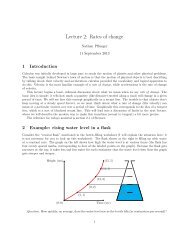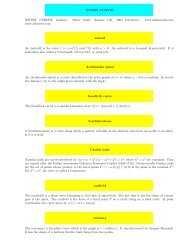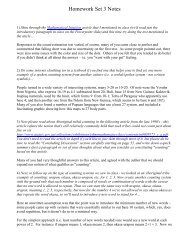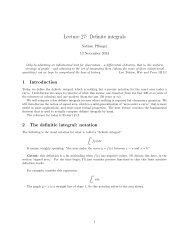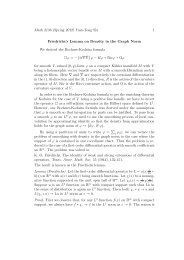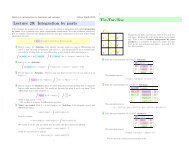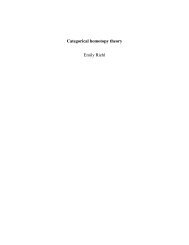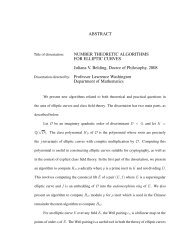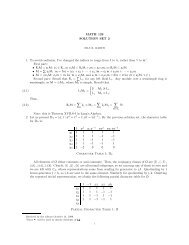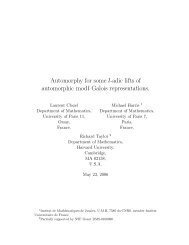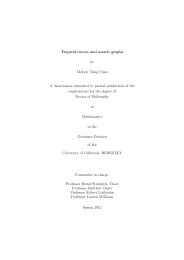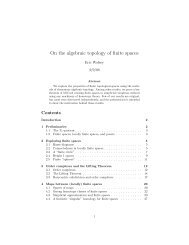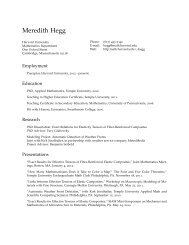Gauge theory for embedded surfaces, II
Gauge theory for embedded surfaces, II
Gauge theory for embedded surfaces, II
Create successful ePaper yourself
Turn your PDF publications into a flip-book with our unique Google optimized e-Paper software.
<strong>Gauge</strong> <strong>theory</strong> <strong>for</strong> <strong>embedded</strong> <strong>surfaces</strong>, <strong>II</strong> 23<br />
We are free to make a convenient choice of metric <strong>for</strong> the index calculation, so<br />
we choose a cone-like singularity with cone-angle 2π/ν, whereνis some multiple<br />
of |n|. We can then pass to the |n|-fold branched cover of W o , branched along<br />
Σ. We call the covering space ˜ W o ; it is a line bundle of degree ±1, according to<br />
the sign of n.<br />
The connection B can be regarded as an orbifold connection on W o , and lifts<br />
to a trivial bundle on ˜ W o . We can write the adjoint bundle of this trivial bundle<br />
as R ⊕ C, so that the covering trans<strong>for</strong>mation acts trivially on the R summand<br />
andwithweightmon the C summand. To calculate the index Iδ, we need only<br />
calculate the invariant part of the cohomology of the exponentially weighted<br />
de<strong>for</strong>mation complex with these trivial coefficients on ˜ W o . With coefficients R,<br />
this complex has trivial H 0 and H 1 , while H 2 is the space of self-dual, harmonic,<br />
L 2 2-<strong>for</strong>ms, which has dimension 0 or 1 according as n is negative or positive.<br />
The covering trans<strong>for</strong>mation clearly acts trivially on this space, so we find that<br />
Iδ is 0 or −1, depending on the sign of n. This is the desired result. ⊓⊔<br />
Remark. The dimension <strong>for</strong>mula can, of course, be arrived at from many directions.<br />
We have chosen the above route because it turns up an interesting point<br />
concerning the comparison of the dimension <strong>for</strong>mulae <strong>for</strong> the cylindrical-end and<br />
twisted moduli spaces. In the argument given, we started with a connection A<br />
on the cylindrical-end space X o , and <strong>for</strong>med a twisted connection A#B on the<br />
pair (X,Σ) by attaching a flat connection B. What we have done is to compare<br />
the <strong>for</strong>mal dimensions <strong>for</strong> A and A#B. The proof shows that the corresponding<br />
moduli spaces differ in dimension by the quantity Iδ; so when the self-intersection<br />
number is negative, the two dimensions are equal, while in the positive case the<br />
dimension of the twisted moduli space is one less, due to the self-dual harmonic<br />
<strong>for</strong>m on W o .<br />
4. Invariants from cylindrical end moduli spaces<br />
The Yang-Mills moduli spaces associated to manifolds with cylindrical ends are<br />
also the source of possible invariants. We describe the two simple cases which<br />
we shall use. Since these are only needed as stepping stones in our proof of<br />
Theorem 1.1, the fact that the invariants we define really are independent of,<br />
<strong>for</strong> example, the Riemannian metric is not of importance. Indeed, we shall later<br />
prove (5.10) that the invariants we construct here can be expressed in terms of<br />
the ordinary invariants, and their ‘invariance’ can be deduced from this, at the<br />
same time showing that we have defined nothing new.



